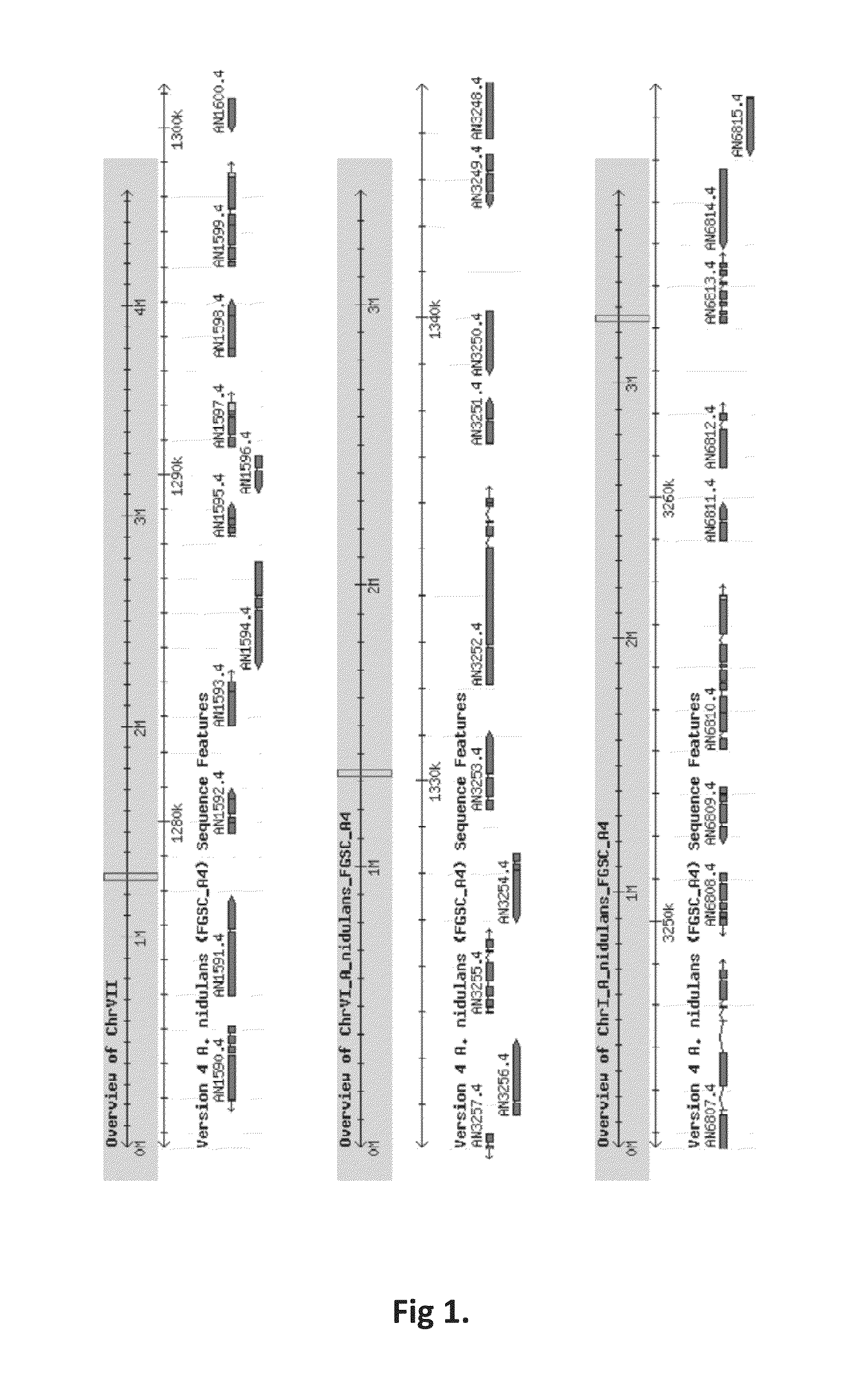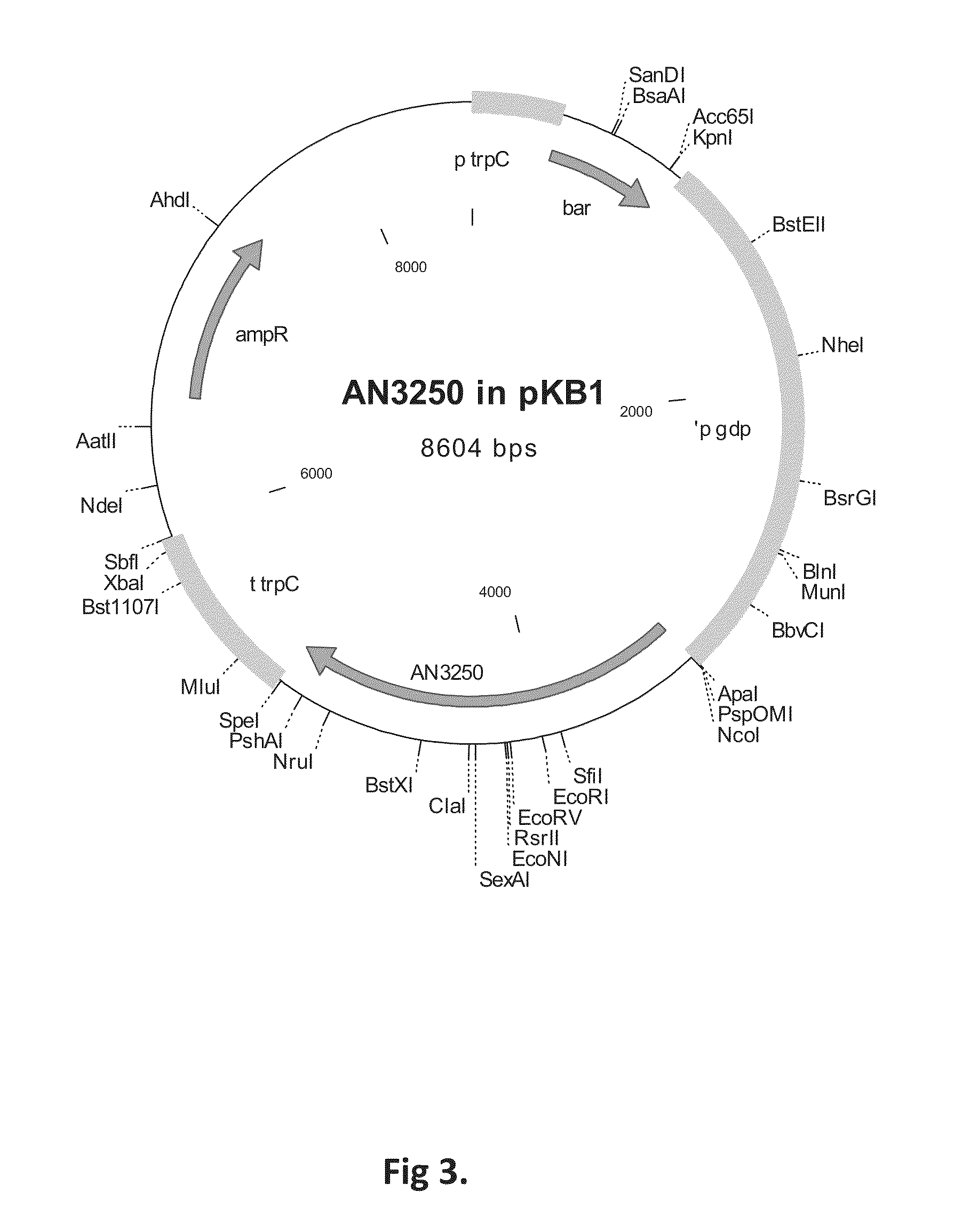Method for producing terpenes
a technology of terpenes and terpenes, which is applied in the field of producing terpenes, can solve the problems of difficulty in obtaining high product yields for terpenes, no publications disclose overexpression of transcription factors specifically activating clusters, and high cost of conventional chemistry production, so as to improve the yield of products
- Summary
- Abstract
- Description
- Claims
- Application Information
AI Technical Summary
Benefits of technology
Problems solved by technology
Method used
Image
Examples
example 1
Locating the Terpenoid Clusters in Different Filamentous Fungi and the Selection of the Clusters to be Studied
[0088]Protein sequences of 33 fungi (Arvas et al.) were mapped to their respective genome sequences by BLAST (Altschul et al.) in order to find genomic co-ordinates for each gene. From the gene co-ordinates windows of 16 and 30 consecutive genes along chromosomal sequence were calculated, moving the window along chromosome with increments of 2 and 5 genes, respectively, to cover all 33 genomes with overlapping windows. For each window its protein domain content i.e. InterPro (Mulder et al.) identifier content was determined based on protein domains of individual genes derived from InterPro data of Arvas et al. All windows containing identifiers IPR008949 ‘Terpenoid synthase’ and IPR008930 ‘Terpenoid cyclase’ were found, and the list of these windows was used as source for selecting gene clusters for laboratory manipulations. Alternatively windows containing IPR008930, IPR001...
example 2
Cloning of the Selected Transcription Factors in Fungal Expression Constructs
[0091]Genomic DNA was extracted by homogenizing 300-500 mg of FGSC A4 mycelia grown over night in YES-medium. 500 μL of glass beads (Acid-washed glass beads, cat #G8772, Sigma), 500 μL 1×TE-buffer, pH 7.5 and 500 μL phenol-chloroform-isoamyl alcohol was added to 2 mL vial with mycelia and homogenized in Fast Prep-homogenizer at speed 6 for 25 seconds. Aqueous layer was separated with 5 minute centrifugation at 15 000 rpm at 4° C., and 650 μL of phenol-chloroform-isoamyl alcohol was added. DNA purification from the aqueous phase was continued according to phenol extraction and ethanol precipitation of DNA-protocol (Current Protocols in Molecular Biology). Concentration of the DNA was measured with Nanodrop (Thermo Scientific).
[0092]Open reading frames (ORFs) of AN1599 (SEQ ID NO: 1), AN3250 (SEQ ID NO: 2) and AN6814 (SEQ ID NO: 3) were amplified with PCR using 43 ng of genomic DNA extracted from Aspergillus ...
example 3
Generating the Fungal Strains Overexpressing the Transcription Factor
[0095]Conidia of Aspergillus nidulans strain FGSC A4 Glasgow wild type (veA+) (Fungal Genetics Stock Center, School of Biological Sciences, University of Missouri. Kansas City, 5007 Rockhill Road, Kansas City, Mo. 64110. USA) were inoculated in YES-medium supplemented with gelatine [20 g Bacto™ Yeast Extract (Cat #212750, Becton, Dickinson and Company), 40 g sucrose (Calbiochem Cat #573113) and 30 g Difco™ Gelatin (Cat #214340, Becton, Dickinson and Company) per liter of dH2O], and grown at +24° C. in shaking flasks over night with 250 rpm. Cultures were transferred to +30° C. shaker the next morning and the grown with 250 rpm for 2 hours. Protoplasts were prepared from Aspergillus nidulans FGSC A4 mycelium, that was filtered through sterile Miracloth, and rinsed with +37° C. dH2O, and room temperature citrate buffer [0.8 M KCl, 0.05 M Na-citrate, pH 5.8]. Filtrated mycelium was resuspended in 100 mL of room temper...
PUM
| Property | Measurement | Unit |
|---|---|---|
| Fraction | aaaaa | aaaaa |
Abstract
Description
Claims
Application Information
 Login to View More
Login to View More - R&D
- Intellectual Property
- Life Sciences
- Materials
- Tech Scout
- Unparalleled Data Quality
- Higher Quality Content
- 60% Fewer Hallucinations
Browse by: Latest US Patents, China's latest patents, Technical Efficacy Thesaurus, Application Domain, Technology Topic, Popular Technical Reports.
© 2025 PatSnap. All rights reserved.Legal|Privacy policy|Modern Slavery Act Transparency Statement|Sitemap|About US| Contact US: help@patsnap.com



